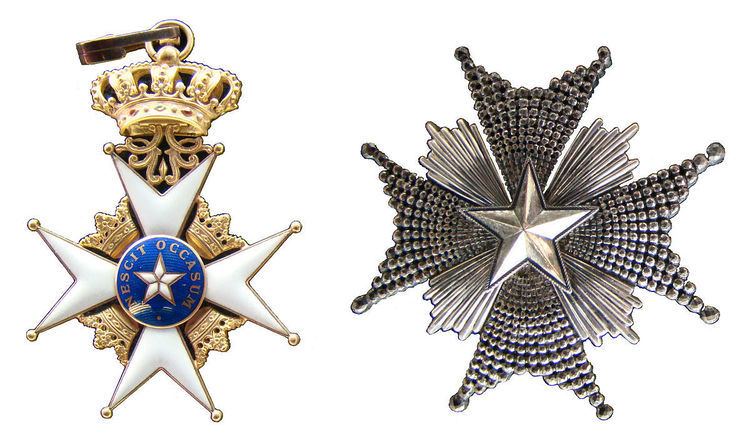Day 28 April | ||
 | ||
Type Five grade order of merit Motto Nescit Occasum (It knows no decline) Eligibility Until 1975: Swedish and foreign personsSince 1975: Foreign citizens and members of the Swedish Royal Family Awarded for Until 1975: Civic merits, for devotion to duty, for science, literary, learned and useful works and for new and beneficial institutions.After 1975: Services to Sweden | ||
The Order of the Polar Star (Swedish: Nordstjärneorden) is a Swedish order of chivalry created by King Frederick I on 23 February 1748, together with the Order of the Sword and the Order of the Seraphim.
Contents
The Order of the Polar Star was until 1975 intended as a reward for Swedish and foreign "civic merits, for devotion to duty, for science, literary, learned and useful works and for new and beneficial institutions".
Its motto is, as seen on the blue enameled centre of the badge, Nescit Occasum, a Latin phrase meaning "It knows no decline". This is to represent that Sweden is as constant as a never setting star. The Order's colour is black. This was chosen so that when wearing the black sash, the white, blue and golden cross would stand out and shine as the light of enlightenment from the black surface. The choice of black for the Order's ribbon may also have been inspired by the black ribbon of the French Order of St. Michael, which at the time the Order of the Polar Star was instituted was also awarded to meritorious civil servants. At present, the ribbon of the Order is blue with yellow stripes near the edges (i.e., the national colors, but the reverse of the Order of the Sword's yellow tibbon with blue stripes near the edges). Women and clergy men are not called knight or commander but simply as Member (Ledamot).
After the reorganization of the orders in 1975 the order is only awarded to foreigners and members of the royal family. It is often awarded to foreign office holders (such as prime and senior ministers) during Swedish state visits. It is also awarded to junior members of royal families who would not qualify for the more prestigious Royal Order of the Seraphim.
Grades
The Order has five degrees:
- Commander Grand Cross (KmstkNO) - Wears the badge on a collar (chain) or on a sash on the right shoulder, plus the star on the left chest;
- Commander 1st Class (KNO1kl) - Wears the badge on a necklet, plus the star on the left chest;
- Commander (KNO) - Wears the badge on a necklet;
- Knight 1st Class (RNO1kl/LNO1kl) - Wears the badge on a ribbon on the left chest;
- Knight (RNO/LNO) - Wears the badge on a ribbon on the left chest.
Note: ^ Clergymen and women become ledamöter (Members) instead of knights.
This order also has a medal, "the Polar Star Medal".
